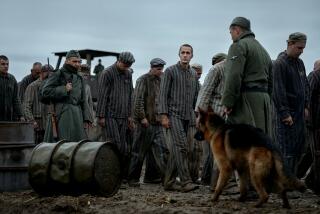A Mystery Long on Plot, Short on Realistic Characterization
- Share via
“The Special Prisoner,” the new novel by Jim Lehrer, who is better known as the anchorman of PBS’ “NewsHour With Jim Lehrer,” is built on an ingenious plot. The young captain of a B-29 bomber, which has been dropping firebombs on Japanese cities toward the end of World War II, is shot down over Japan and parachutes to earth. Japanese villagers beat him severely, and he faces worse in prison. Regarded as war criminals by the Japanese, the men of the bomber crews are tortured and murdered.
The principal tormentor of the B-29 captain is one Tashimoto, nicknamed “the Hyena” by the prisoners for his maniacal laughter. Tashimoto kicks and beats the captain, John Quincy Watson, so badly that he will be forever impotent.
After a long postwar convalescence, Watson becomes a Christian and then an ordained Methodist minister. He rises to bishop of San Antonio, renowned for his preaching.
Now, 50 years after the end of the war, he is retired and rests secure in the belief that he has forgiven his torturers.
*
Until, that is, one day in the Dallas-Fort Worth Airport when, as he’s changing planes, he sees a Japanese man whose hateful eyes are unforgettable. Tashimoto! Watson loses him in the crowd, then traces him to a plane for San Diego. The name on the manifest is indeed Tashimoto’s.
Driven by an overpowering need to talk with Tashimoto, Watson traces him to his hotel and confronts him. Tashimoto denies that he was the infamous prison guard. But they do talk, and so they are arguing, ever more fiercely, about who was the more guilty--the Americans for bombing the men, women and children in the Japanese cities, or the Japanese for tormenting their American flier prisoners.
The argument escalates and the consequences are dire.
In the guise of a thriller, “The Special Prisoner” is an inquiry into the nature of guilt and responsibility. In the caldron of World War II, which acts of murder were justified? Was the firebombing of Tokyo justified? Did the Japanese have any ground for considering the U.S. airmen war criminals?
Lehrer poses another awful question: Was this Tashimoto in fact the Tashimoto who tortured Watson or was he, as he claimed, another Tashimoto?
*
Lehrer, the wisest, steadiest and calmest of TV anchors, runs through his plot deftly. He springs surprise after surprise upon the reader. His scenes are carefully done, with attention to authentic detail. A sermon Watson delivers sounds like a sermon; the visitors’ room in a California prison is just like a real prison visiting room.
But Lehrer, the wisest, steadiest and calmest of anchormen, is not, in the full sense of the word, a novelist.
He can set the scene and craft the plot, but the world he has created is not filled with real people. They are ideas of people, cutouts of people. It is hard to believe in Tashimoto as a real person, or Watson as a real clergyman. Only in the end does Watson take on flesh and blood, in the moral resolution of the novel.
*
Lehrer has created an intellectually interesting discussion of human guilt and responsibility. And although his actors are not as authentic as the scenes through which they move, Lehrer has succeeded well in that other essential of all thrillers--a plot that will make you wonder what’s going to happen next.
More to Read
Sign up for our Book Club newsletter
Get the latest news, events and more from the Los Angeles Times Book Club, and help us get L.A. reading and talking.
You may occasionally receive promotional content from the Los Angeles Times.










